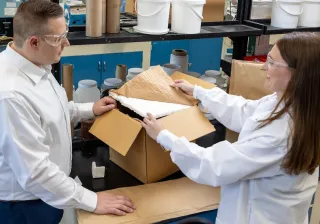In the Finnish mechanical and chemical forest industry, three million tonnes of softwood bark are produced annually, presently mainly used for energy production. Using a method developed by VTT, a high yield of pure tannins can be extracted from the bark for use as a raw material for resins used in wood products. The residual fibre fraction can be used to produce sugar as a raw material for fermentation products. It is also suitable for material applications.
Traditionally, tannins are extracted from the bark by hot water extraction. In addition to tree species, the extraction yield is influenced by the origin and processing history of the raw material. From Scandinavian spruce and pine, the yield remains at most 10% of bark weight. The utilization of bark residues as a source of sugar has been studied through enzymatic hydrolysis. Even in this process, the yields have not been very high, and consequently much of the bark tannin and carbohydrates have remained unutilized.
The new process uses much higher alkaline conditions and a higher temperature, more closely resembling the wood cooking process. About one third of the bark weight can be dissolved and isolated as a tannin fraction with significantly less impurities – carbohydrates and ashes – than in a fraction obtained by hot water extraction. This tannin extract is a much more reactive resin raw material than normal kraft lignin. The same technology as used for lignin recovery is suitable for the recovery of the tannin. In addition to tannin, there is some lignin in the fraction.
The fibre fraction can be hydrolysed considerably more easily than after hot water extraction. The hydrolyzate is well-suited for fermentation. The purpose is to further test the suitability of a fibre fraction for material applications.
The method for the total utilization of the bark has been developed by VTT as part of the EU's SPIRE program project, "Systemic Approach to Reduce Energy Demand and CO2 Emissions of Processes that Transform Agroforestry Waste into High-Added-Value Products".
BBEPP from Belgium (upscaling), FORESA from Spain (tannin fraction for resin) and BIOSYNCAUCHO from Spain (hydrolyzate fermentation) have participated in the further development and validation of the process and the resulting fractions. The project co-ordinator is Spanish TECNALIA.
In order to bring the method into production, a company consortium is being created, which is expected to include an interested supplier of raw material, equipment supplier and application testers to utilize the tannin and fibre fractions.



